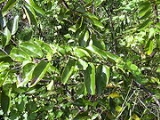
Annona
Overview
Annona is a genus of flowering plant
s in the pawpaw/sugar apple family, Annonaceae
. It is the second largest genus in the family after Guatteria
, containing approximately 110 species of mostly neotropical and afrotropical tree
s and shrub
s.
The generic name derives from anón, a Hispaniola
n Taíno
word for the fruit. Paleoethnobotanical
studies have dated Annona exploitation
and cultivation
in the Yautepec River region
of Mexico
to approximately 1000 BC.
Currently, seven Annona species
and one hybrid are grown for domestic or commercial use, mostly for the edible and nutritious fruits; several others also produce edible fruits.
Many of the species are used in traditional medicines for the treatment of a variety of diseases.
Flowering plant
The flowering plants , also known as Angiospermae or Magnoliophyta, are the most diverse group of land plants. Angiosperms are seed-producing plants like the gymnosperms and can be distinguished from the gymnosperms by a series of synapomorphies...
s in the pawpaw/sugar apple family, Annonaceae
Annonaceae
Annonaceae, also called the custard apple familyis a family of flowering plants consisting of trees, shrubs or rarely lianas.With about 2300 to 2500 species and more than 130 genera,...
. It is the second largest genus in the family after Guatteria
Guatteria
Guatteria is a genus of plant in family Annonaceae. It contains the following species :* Guatteria anomala, R.E. Fries* Guatteria atabapensis, Aristeg.* Guatteria augusti, Diels...
, containing approximately 110 species of mostly neotropical and afrotropical tree
Tree
A tree is a perennial woody plant. It is most often defined as a woody plant that has many secondary branches supported clear of the ground on a single main stem or trunk with clear apical dominance. A minimum height specification at maturity is cited by some authors, varying from 3 m to...
s and shrub
Shrub
A shrub or bush is distinguished from a tree by its multiple stems and shorter height, usually under 5–6 m tall. A large number of plants may become either shrubs or trees, depending on the growing conditions they experience...
s.
The generic name derives from anón, a Hispaniola
Hispaniola
Hispaniola is a major island in the Caribbean, containing the two sovereign states of the Dominican Republic and Haiti. The island is located between the islands of Cuba to the west and Puerto Rico to the east, within the hurricane belt...
n Taíno
Taíno language
Taíno, an Arawakan language, was the principal language of the Caribbean islands at the time of the Spanish Conquest, including the Bahamas, Cuba, Hispaniola, Jamaica, Puerto Rico, the Florida Keys, and the Lesser Antilles...
word for the fruit. Paleoethnobotanical
Paleoethnobotany
Paleoethnobotany, also known as archaeobotany in European academic circles, is the archaeological sub-field that studies plant remains from archaeological sites...
studies have dated Annona exploitation
Exploitation of natural resources
Main article: OverexploitationSome exploitation of natural resources is an essential condition of the human existence. This refers primarily to food production and necessities...
and cultivation
Agriculture in Mesoamerica
Agriculture in Mesoamerica dates to the Archaic period of Mesoamerican chronology . During this period, many of the hunter gatherer micro-bands in the region began to cultivate wild plants...
in the Yautepec River region
Yautepec de Zaragoza
Yautepec is a city and its surrounding municipality of the same name located in the north-central part of the Mexican state of Morelos. It stands at ....
of Mexico
Mexico
The United Mexican States , commonly known as Mexico , is a federal constitutional republic in North America. It is bordered on the north by the United States; on the south and west by the Pacific Ocean; on the southeast by Guatemala, Belize, and the Caribbean Sea; and on the east by the Gulf of...
to approximately 1000 BC.
Currently, seven Annona species
Species
In biology, a species is one of the basic units of biological classification and a taxonomic rank. A species is often defined as a group of organisms capable of interbreeding and producing fertile offspring. While in many cases this definition is adequate, more precise or differing measures are...
and one hybrid are grown for domestic or commercial use, mostly for the edible and nutritious fruits; several others also produce edible fruits.
Many of the species are used in traditional medicines for the treatment of a variety of diseases.

